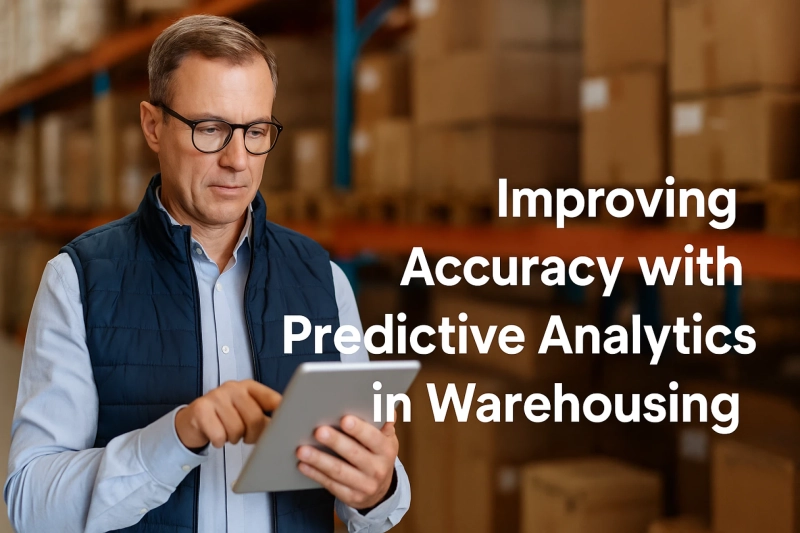As the logistics and supply chain landscape becomes increasingly data-driven, warehousing has emerged as a key area of digital transformation. Modern warehouses are no longer just storage facilities; they are intelligent ecosystems powered by real-time data and automation. At the heart of this evolution lies predictive analytics in warehousing—a game-changing approach that allows businesses to anticipate demand, optimize storage, and streamline operations.
In this blog, we explore the practical applications, benefits, and real-world use cases of predictive analytics in warehousing, helping businesses understand how to stay competitive and efficient in today’s fast-paced environment.
What is Predictive Analytics in Warehousing?
Predictive analytics refers to the use of historical data, machine learning algorithms, and statistical techniques to forecast future trends and behaviors. In warehousing, this means:
- Anticipating inventory requirements
- Predicting demand spikes
- Optimizing workforce and resources
- Preventing equipment failures
- Managing supply chain disruptions proactively
Unlike traditional analytics that focus on what happened in the past, predictive models look forward—providing actionable insights to prepare for what lies ahead.
Why It Matters in Modern Warehousing
Warehouses today face numerous challenges: rising labor costs, supply chain disruptions, fluctuating demand, and the pressure for faster delivery. Predictive analytics enables warehousing teams to turn these challenges into strategic advantages by leveraging data-driven insights.
- 79% of supply chain leaders say that predictive analytics improves decision-making in warehouse management.
- According to McKinsey, predictive logistics can reduce inventory costs by 20% to 30% while improving service levels by up to 65%.
Key Use Cases of Predictive Analytics in Warehousing
1. Inventory Forecasting
By analyzing purchase history, seasonal trends, and current demand signals, predictive models can accurately forecast future inventory needs. This prevents overstocking and stockouts, improving customer satisfaction and reducing holding costs.
2. Demand Planning
With predictive insights, businesses can adjust warehouse operations to meet upcoming surges in demand—such as holiday seasons or promotional campaigns. This ensures smooth order fulfillment without delays.
3. Warehouse Space Optimization
Predictive analytics identifies which products move faster and which stay idle. This information helps allocate shelf space more efficiently, reducing congestion and improving warehouse layout design.
4. Predictive Maintenance
IoT sensors combined with predictive analytics can forecast potential breakdowns in warehouse machinery like forklifts, conveyors, and sorters. This helps prevent unexpected downtime and costly repairs.
5. Labor Management
Using historical workforce data and seasonal trends, predictive tools help plan optimal staffing levels to ensure smooth operations without overburdening employees.
6. Order Picking Efficiency
By forecasting order patterns, predictive systems can organize picking routes and storage locations to minimize travel time within the warehouse, thereby improving overall productivity.
7. Supply Chain Risk Mitigation
Predictive analytics helps identify risks such as delayed supplier shipments or transportation bottlenecks and provides recommendations to counteract them.
How Predictive Analytics Works in Warehousing
Here’s a step-by-step breakdown of how the system functions:
- Data Collection: Gather real-time and historical data from WMS (Warehouse Management Systems), ERP software, IoT devices, and other logistics platforms.
- Data Cleaning and Preparation: Filter out redundant, inconsistent, or missing values to ensure high-quality input.
- Model Building: Machine learning models are trained on historical data to identify patterns and predict future outcomes.
- Deployment: These models are integrated into warehouse systems, providing live recommendations and forecasts.
- Continuous Learning: As new data flows in, models are retrained to improve accuracy and reliability over time.
Benefits of Predictive Analytics in Warehousing
- Reduced Operational Costs: Avoid overstocking and underutilization by accurately forecasting needs.
- Increased Productivity: Streamlined order processing and workforce planning improve throughput.
- Enhanced Customer Satisfaction: Faster deliveries and accurate order fulfillment build trust.
- Better Decision Making: Real-time dashboards offer actionable insights to warehouse managers.
- Risk Reduction: Anticipate and resolve potential failures before they disrupt operations.
Real-World Examples
Example 1: Amazon
Amazon uses predictive analytics to determine where to stock products, ensuring that most orders are fulfilled from nearby warehouses—reducing delivery time and shipping costs.
Example 2: Walmart
Walmart integrates predictive tools to forecast demand and allocate inventory across its distribution centers. This helped them maintain stock availability during peak COVID-19 disruptions.
Example 3: DHL
DHL uses predictive models to optimize their warehouse layouts, minimizing walking distance for pickers and improving handling speed.
Implementation Tips for Businesses
- Start with Clear Objectives: Focus on a specific goal, like reducing stockouts or optimizing labor.
- Ensure Data Quality: Clean, consistent data is the backbone of reliable predictions.
- Choose the Right Tools: Consider platforms like SAP, Oracle, or custom-built AI models depending on your needs.
- Invest in Talent: Hire or train staff to understand and manage predictive systems effectively.
- Scale Gradually: Begin with pilot programs before full-scale implementation.
Future Trends in Predictive Warehousing
- AI-Powered Autonomous Warehouses: Integration of AI with robotics and predictive systems for self-operating warehouses.
- Digital Twins: Creating virtual warehouse replicas to simulate and test optimization scenarios.
- Real-Time Predictive Dashboards: Advanced dashboards offering instant analytics and insights.
Conclusion
Predictive analytics in warehousing is no longer a competitive advantage—it's a necessity. Businesses that embrace this transformation can achieve greater operational efficiency, reduce waste, and deliver exceptional customer service. As warehousing becomes more data-centric, predictive models will play a vital role in shaping the future of logistics and fulfillment.
For companies ready to tap into the power of advanced analytics, partnering with experienced experts like Kody Technolab can accelerate the journey toward a smarter, data-driven warehouse ecosystem.


